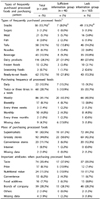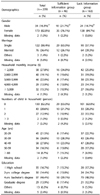1. Lee CH, Cho YH, Park KH. Assessment of estimated daily intake of nitrite by average consumption of processed foods in Korea. Food Control. 2006; 17:950–956.

2. Altu T, Elmaci Y. A consumer survey on food additives. Dev Food Sci. 1995; 37:705–719.

3. Seo KW, Yang YS, Cho BS, Gang GL, Kim JP, Kim ES, Park JT. The survey on food additives in frequently consumed food. J Food Hyg Saf. 2008; 23:142–148.
4. Aoki K, Shen J, Saijo T. Consumer reaction to information on food additives: evidence from an eating experiment and a field survey. J Econ Behav Organ. 2010; 73:433–438.

5. European Food Information Council (BE). European Food Information Council [Internet]. Brussels: European Food Information Council;2006. cited 2013 February 5]. Available from:
http://www.eufic.org/.
6. Varela P, Fiszman SM. Exploring consumers' knowledge and perceptions of hydrocolloids used as food additives and ingredients. Food Hydrocoll. 2013; 30:477–484.

7. Kim EJ, Na HJ, Kim Y. Awareness on food additives and purchase of processed foods containing food additives in middle school students. J Korean Living Sci Assoc. 2007; 16:205–218.

8. Shim SM, Seo SH, Lee Y, Moon GI, Kim MS, Park JH. Consumers' knowledge and safety perceptions of food additives: evaluation on the effectiveness of transmitting information on preservatives. Food Control. 2011; 22:1054–1060.

9. Miles S, Brennan M, Kuznesof S, Ness M, Ritson C, Frewer LJ. Public worry about specific food safety issues. Br Food J. 2004; 106:9–22.

10. Williams P, Stirling E, Keynes N. Food fears: a national survey on the attitudes of Australian adults about the safety and quality of food. Asia Pac J Clin Nutr. 2004; 13:32–39.
11. McCarthy M, Brennan M, Ritson C, de Boer M. Food hazard characteristics and risk reduction behaviour: the view of consumers on the island of Ireland. Br Food J. 2006; 108:875–891.
12. Rimal A, Fletcher SM, McWatters KH, Misra SK, Deodhar S. Perception of food safety and changes in food consumption habits: a consumer analysis. Int J Consum Stud. 2001; 25:43–52.

13. Brewer MS, Rojas M. Consumer attitudes toward issues in food safety. J Food Saf. 2008; 28:1–22.

14. Lee HK. Consumers' awareness of food additives. Safe food. 2012; 7:21–25.
15. Unusan N. Consumer food safety knowledge and practices in the home in Turkey. Food Control. 2007; 18:45–51.

16. Stern T, Haas R, Meixner O. Consumer acceptance of wood-based food additives. Br Food J. 2009; 11:179–195.

17. Deliza R, Rosenthal A, Silva AL. Consumer attitude towards information on non conventional technology. Trends Food Sci Technol. 2003; 14:43–49.

18. Worsley A. Nutrition knowledge and food consumption: can nutrition knowledge change food behaviour? Asia Pac J Clin Nutr. 2002; 11:Suppl 3. S579–S585.

19. Kim H, Kim M. Consumers' awareness of the risk elements associated with foods and information search behavior regarding food safety. J East Asian Soc Diet Life. 2009; 19:116–129.
20. Back BS, Lee YH. Consumer's awareness and policies directions on food additives-focusing on consumer information. J Consum Stud. 2006; 17:133–150.
21. Ababio PF, Adi DD, Amoah M. Evaluating the awareness and importance of food labelling information among consumers in the Kumasi metropolis of Ghana. Food Control. 2012; 26:571–574.

22. Mahgoub SE, Lesoli PP, Gobotswang K. Awareness and use of nutrition information on food packages among consumers in Maseru (Lesotho). Afr J Food Agric Nutr Dev. 2007; 7:1–16.

23. Williams ER, Caliendo MA. Nutrition: principles, issues, and applications. New York (NY): McGraw-Hill Inc.;1984.
24. Sharif Ishak SI, Shohaimi S, Kandiah M. Assessing the children's views on foods and consumption of selected food groups: outcome from focus group approach. Nutr Res Pract. 2013; 7:132–138.

25. Ajzen I. The theory of planned behavior. Organ Behav Hum Decis Process. 1991; 50:179–211.

26. Seo HS, Lee SK, Nam S. Factors influencing fast food consumption behaviors of middle-school students in Seoul: an application of theory of planned behaviors. Nutr Res Pract. 2011; 5:169–178.

27. Pawlak R, Colby S, Herring J. Beliefs, benefits, barriers, attitude, intake and knowledge about peanuts and tree nuts among WIC participants in eastern North Carolina. Nutr Res Pract. 2009; 3:220–225.

28. Kim K, Reicks M, Sjoberg S. Applying the theory of planned behavior to predict dairy product consumption by older adults. J Nutr Educ Behav. 2003; 35:294–301.

29. Sun X, Guo Y, Wang S, Sun J. Predicting iron-fortified soy sauce consumption intention: application of the theory of planned behavior and health belief model. J Nutr Educ Behav. 2006; 38:276–285.

30. Wilcock A, Pun M, Khanona J, Aung M. Consumer attitudes, knowledge and behaviour: a review of food safety issues. Trends Food Sci Technol. 2004; 15:56–66.

31. Lobb AE, Mazzocchi M, Traill WB. Modelling risk perception and trust in food safety information within the theory of planned behaviour. Food Qual Prefer. 2007; 18:384–395.
32. Ergönül B. Consumer awareness and perception to food safety: a consumer analysis. Food Control. 2013; 32:461–471.

33. Lee JS. Perception on nutrition labeling of the processed food among elementary school teachers in Busan. Korean J Community Nutr. 2009; 14:430–440.
34. Kim HC, Kim MR. Consumer attitudes towards food additives. J East Asian Soc Diet Life. 2005; 15:126–135.
35. Behrens JH, Barcellos MN, Frewer LJ, Nunes TP, Franco BD, Destro MT, Landgraf M. Consumer purchase habits and views on food safety: a Brazilian study. Food Control. 2010; 21:963–969.

36. Bredahl L. Consumers' cognitions with regard to genetically modified foods. Results of a qualitative study in four countries. Appetite. 1999; 33:343–360.

37. Yoon E, Seo SH. Differences on perceptions and attitudes towards food safety based on behavioral intention to prevent foodborne illness among middle school students in Seoul. Korean J Food Cookery Sci. 2012; 28:149–158.

38. Worsley A, Scott V. Consumers' concerns about food and health in Australia and New Zealand. Asia Pac J Clin Nutr. 2000; 9:24–32.

39. Kher SV, De Jonge J, Wentholt MT, Deliza R, de Andrade JC, Cnossen HJ, Luijckx NB, Frewer LJ. Consumer perceptions of risks of chemical and microbiological contaminants associated with food chains: a cross-national study. Int J Consum Stud. 2013; 37:73–83.

40. Caswell JA, Mojduszka EM. Using informational labeling to influence the market for quality in food products. Am J Agric Econ. 1996; 78:1248–1253.

41. Raats MM, Shepherd R. Developing a subject-derived terminology to describe perceptions of chemicals in foods. Risk Anal. 1996; 16:133–146.

42. Xu P, Zeng Y, Fong Q, Lone T, Liu Y. Chinese consumers' willingness to pay for green- and eco-labeled seafood. Food Control. 2012; 28:74–82.

43. Kim HY, Lee NR, Lee JS, Choi YS, Kwak TK, Chung HR, Kwon S, Choi YJ, Lee SK, Kang MH. Meal skipping relates to food choice, understanding of nutrition labeling, and prevalence of obesity in Korean fifth grade children. Nutr Res Pract. 2012; 6:328–333.

44. Kim WK, Kim J. A study on the consumer's perception of front-of-pack nutrition labeling. Nutr Res Pract. 2009; 3:300–306.

45. Yates AA. Establishing new principles for nutrient reference values (NRVs) for food labeling purposes. Nutr Res Pract. 2007; 1:89–93.

46. Sharf M, Sela R, Zentner G, Shoob H, Shai I, Stein-Zamir C. Figuring out food labels. Young adults' understanding of nutritional information presented on food labels is inadequate. Appetite. 2012; 58:531–534.

47. Borgmeier I, Westenhoefer J. Impact of different food label formats on healthiness evaluation and food choice of consumers: a randomized-controlled study. BMC Public Health. 2009; 9:184.

48. Cook AJ, Kerr GN, Moore K. Attitudes and intentions towards purchasing GM food. J Econ Psychol. 2002; 23:557–572.

49. Dickson-Spillmann M, Siegrist M, Keller C. Attitudes toward chemicals are associated with preference for natural food. Food Qual Prefer. 2011; 22:149–156.











 PDF
PDF ePub
ePub Citation
Citation Print
Print



 XML Download
XML Download